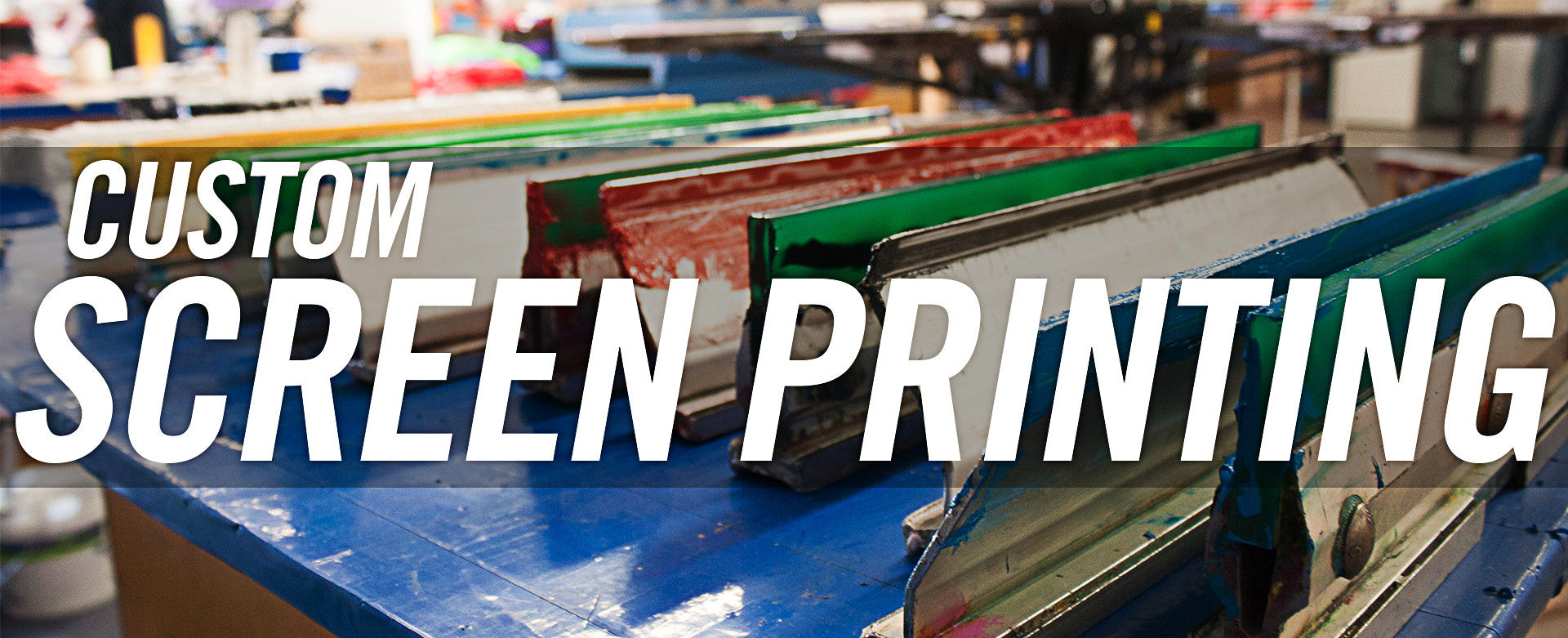Eco-Friendly Custom Screen Printing Options Available
Eco-Friendly Custom Screen Printing Options Available
Blog Article
Display Printing Uncovered: Everything You Need to Find Out About Tee Shirt and Garment Printing Techniques
Display printing is an interesting approach that combines art with technique, offering endless possibilities for creativity. Prepared to discover the necessary elements that make screen publishing an art form?
The Essentials of Display Printing: Just How It Functions
When you dive into display printing, you'll find it's both a scientific research and an art. At its core, screen printing entails developing a stencil, or display, that allows ink to pass through only in specific locations.
Placement the display over the fabric, then make use of a squeegee to push ink through the display onto the garment. Each action is important, and understanding them will certainly boost your screen printing skills, changing simple garments into one-of-a-kind, expressive pieces.
Sorts Of Screen Printing Techniques
As soon as you comprehend the fundamentals of screen printing, it's time to explore the numerous techniques that can raise your layouts. One prominent method is conventional display printing, where ink is pushed with a stenciled screen. This method is great for vibrant, lively colors. Then there's water-based ink printing, which supplies a softer feel and is green, however it requires a various method to curing.
If you're going for fine details, take into consideration discharge printing. This strategy gets rid of dye from the fabric, leaving a soft, classic appearance. Another choice is plastisol printing, understood for its longevity and vivid shades, making it a favorite for many brands. Experiment with halftone printing to produce slope impacts and elaborate layouts. Each method has its one-of-a-kind charm, so do not think twice to try them bent on locate what matches your style best!
Important Tools for Screen Printing
To attain spectacular results in display printing, having the best devices is fundamental. Initially, you'll require a sturdy screen printing structure, which holds the mesh that transfers your style onto the garment. Next off, spend in top quality mops; these are necessary for using ink equally across the display. You'll additionally require an excellent direct exposure device to create your displays, as well as a washout cubicle for cleansing them after use. A reliable warm source, like a conveyor dryer or warm press, is critical for treating your prints to guarantee long life. Do not forget a proper workspace, furnished with tables and storage for your supplies. Finally, safety gear, such as masks and gloves, will maintain you secure from chemicals and inks. With the right devices, you'll be well on your way to creating professional-quality prints.
Picking the Right Inks and Products
When picking inks and products for display printing, you need to think about the sort of ink that works best for your task. Assume concerning textile compatibility to assure your layouts look last and excellent long. Also, check out green ink alternatives to make your printing process much more sustainable.
Kinds of Display Inks
Picking the right display ink is important for achieving vivid, long lasting prints that satisfy your project's demands. There are a number of sorts of screen inks to analyze. Plastisol ink is popular for its flexibility and ease of use, providing superb shade opacity on dark textiles. Water-based ink, on the various other hand, provides a softer feel and is environment-friendly, making it excellent for those looking to decrease their environmental influence. Discharge inks remove dye from the material, resulting in a soft, vintage look but call for specific handling. Specialized inks, such as glow-in-the-dark or metallic, can include unique effects to your designs. Assess your project demands and choose the ink that aligns ideal with your wanted result.

Fabric Compatibility Factors To Consider
Understanding textile compatibility is important for attaining high-quality display prints, specifically considering that different materials respond distinctly to various inks. Always examine your inks on sample material to guarantee they stick properly and preserve color honesty. Furthermore, maintain in mind that textile weight and appearance can impact the last outcome, so selecting the ideal ink and product combo is essential for your project's success.
Eco-Friendly Ink Options
Environment-friendly inks are becoming a preferred selection for screen printers that desire to lessen their environmental influence while keeping top quality. When choosing inks, take into consideration water-based inks, which are much less dangerous and simpler to tidy up contrasted to typical solvents. These inks bond well with materials, providing vivid results without toxic chemicals. You might also discover eco-solvent inks that make use of less unpredictable natural substances (VOCs), making them a safer option for both your wellness and the earth.
Additionally, seek inks made from renewable energies, such as soy or vegetable-based options. By selecting the right inks and materials, you'll not only create stunning layouts but also add to a more lasting printing process. Make the button, and your prints will certainly show your commitment to the environment!
Preparing Your Design for Display Printing

Submit Format Requirements
To assure your style looks vibrant and sharp on fabric, you'll require to pay attention to file style requirements for screen printing. Begin with vector data like AI or EPS, as they can be scaled without shedding top quality. If you use raster images, choose high-resolution data, such as TIFF or PNG, ideally at 300 DPI. Stay clear of making use of JPEGs, as they can shed clearness when resized. Make certain your layout has a transparent history to avoid undesirable white sides on your prints. Ultimately, keep shade settings in mind; CMYK is common for display printing, so transform your RGB this article designs appropriately. By adhering to these standards, you'll establish your art work up for a successful print.
Shade Splitting Up Techniques
Color separation is a vital action in preparing your style for screen printing, and grasping it can considerably improve your print high quality. You'll require to break your style right into specific shades, as each color requires a separate display throughout printing. Begin by recognizing all the shades in your layout and develop layers each. You can use software application like Adobe Photoshop or Illustrator to separate and separate colors successfully. Be particular to conserve each layer as a separate data, commonly in a format like TIFF or PSD. This precision not only assures accurate shade depiction but also improves the printing process. By taking notice of shade splitting up, you'll attain vivid and expert lead to your screen-printed garments.
Resolution and Dimension
Achieving the most effective cause display printing starts with guaranteeing your style has the right resolution and size. Preferably, your artwork should go to least 300 DPI (dots per inch) for sharp, clear prints. If you utilize reduced resolution, your final item may look amateur and pixelated.
When it pertains to size, consider the dimensions of your print area. Layout your art work to match the last print size, ideally developing it in the real dimensions you'll be printing. In this manner, you'll avoid any type of unforeseen scaling concerns.
Always examine your design in both vector and raster formats. Vector graphics can be scaled without losing top quality, making them navigate here optimal for display printing. Preparing correctly will guarantee your style looks remarkable on every garment!
Step-by-Step Display Printing Process
Screen printing is a dynamic process that enables you to develop vivid designs on numerous surface areas. To get started, you'll need a screen, emulsion, and your selected ink.
After rinsing the unexposed solution, your display prepares. Set it up on your printing surface area and align your garment below it. Put ink onto the display and make use of a squeegee to press the ink through the stencil onto the material. Raise the display meticulously and allow the print dry. Ultimately, cure the ink utilizing warmth to ensure sturdiness. That's it! You have actually successfully screen printed your design.
Tips for Effective Screen Printing Projects
While you're diving into your screen printing projects, keep in mind that prep work is key to success. Start by collecting all your materials-- inks, mops, garments, and screens. A clean workspace helps avoid undesirable errors, so clean up prior to you start.
Following, validate your artwork is high-resolution and correctly sized for your garment. Test your display for correct direct exposure and clean it thoroughly to avoid smudges. When blending your inks, follow the maker's standards to achieve the ideal consistency.
Throughout printing, apply also stress with your squeegee for constant results. Don't hurry; take your time to confirm each print fulfills your requirements. After printing, let your garments dry totally before handling or packaging them.
Finally, constantly keep a sample of your help future referral. This method, you can evaluate your development and improve your techniques over time. Delighted printing!

Regularly Asked Inquiries
For how long Does It Take to Set up a Display Printing Job?
Establishing a display printing job commonly takes around half an hour to an hour. You'll prepare the displays, mix inks, and readjust journalism. The time varies based upon intricacy and experience, so stay organized!
Can I Print on Different Fabric Types Utilizing the Very Same Strategy?
Yes, you can print on different textile types utilizing the exact same method, however you'll require to readjust your settings and inks. Some materials soak up ink in a different way, so exploring assurances the most effective outcomes for every material.
What Prevail Blunders to Avoid in Screen Printing?
When screen printing, avoid usual errors like utilizing the incorrect ink, overlooking proper direct exposure times, or missing pre-press checks. Constantly test your arrangement and keep clean screens to ensure quality results each time.
Exactly How Can I Properly Clean and Preserve My Display Printing Tools?
To properly clean and preserve your display printing tools, you ought to frequently clean screens with proper solvents, check mops for wear, and ensure all tools are kept dust-free and completely dry. Uniformity stops costly repair services and enhances efficiency.
Is Screen Printing Eco-friendly Contrasted to Other Methods?
Screen printing can be a lot more eco-friendly than various other methods, particularly if you use water-based inks and eco-conscious materials. By choosing lasting materials and techniques, you minimize waste and lessen your impact on the world.
Screen Printing Uncovered: Every Little Thing You Need to Know Concerning Tee and Garment Printing Methods
At its core, display printing involves creating a stencil, or screen, that allows ink to pass via just in particular locations. Setting the display over the textile, then utilize a squeegee to press ink through the display onto the garment. One popular approach is typical display printing, where ink is pressed with a stenciled display.When selecting inks and products for screen printing, you need to take into account the kind of ink that works finest for your task.
Report this page